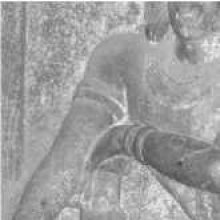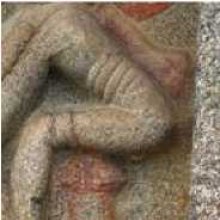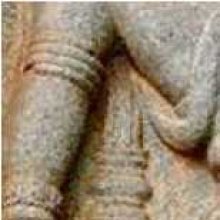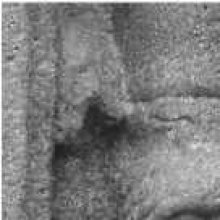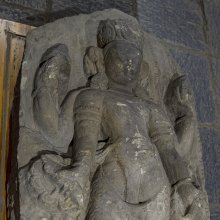Mace: 1 definition
Introduction:
Mace means something in Hinduism, Sanskrit. If you want to know the exact meaning, history, etymology or English translation of this term then check out the descriptions on this page. Add your comment or reference to a book if you want to contribute to this summary article.
Images (photo gallery)
(+11 more images available)
In Hinduism
Mantrashastra (the science of Mantras)
Source: Shodhganga: Kasyapa Samhita—Text on Visha Chikitsa (mantra)The Mace (in Sanskrit: Gadā) refers to one of the five “signs” or “hand-positions” that should accompany the chanting of mantras, according to the Śeṣa-samhitā (p.26, mudrāvidhi).—Mudrā is the position of the hand and finger indicative of various moods and sentiments, and accelerate the effectiveness of the accompanying mantras. The Śeṣasamhitā states that the five Mudrās [e.g., mace (gadā-mudrā)] yield the four puruṣārthas when displayed in the middle and end of a japa. Mantras refers to “that which is chanted by people to obtain their spiritual aspirations”.
Mantrashastra (शिल्पशास्त्र, mantraśāstra) refers to the ancient Indian science of mantras—chants, incantations, spells, magical hymns, etc. Mantra Sastra literature includes many ancient books dealing with the methods reciting mantras, identifying and purifying its defects and the science behind uttering or chanting syllables.
See also (Relevant definitions)
Starts with: Macela, Macela dourada, Macela-do-campo.
Ends with: Atemamace, Camace, Mullucamace, Sweet mace.
Full-text (+375): Gada, Kaumodaki, Drughana, Jatipatri, Kaupodaki, Copadara, Gadin, Trijataka, Gudatvaca, Jayapatri, Mayapatri, Cobadara, Musala, Vetrapani, Gadabhrit, Gadadhara, Gurja, Jatikosa, Rajabhogya, Shrutayudha.
Relevant text
Search found 108 books and stories containing Mace; (plurals include: Maces). You can also click to the full overview containing English textual excerpts. Below are direct links for the most relevant articles:
Mahabharata (English) (by Kisari Mohan Ganguli)
The Padma Purana (by N.A. Deshpande)
Chapter 66 - The Slaying of Kāleya < [Section 1 - Sṛṣṭi-khaṇḍa (section on creation)]
Chapter 73 - The Slaying of Vṛtra < [Section 1 - Sṛṣṭi-khaṇḍa (section on creation)]
Chapter 26 - A Fierce Fight Between Lakṣmīnidhi and Suketu < [Section 5 - Pātāla-Khaṇḍa (Section on the Nether World)]
The Bhagavata Purana (by G. V. Tagare)
Chapter 18 - Hiraṇyākṣa’s Fight with Varāha < [Book 3 - Third Skandha]
Chapter 72 - Jarāsandha slain < [Book 10 - Tenth Skandha]
Chapter 66 - Slaying of Pauṇḍraka and others < [Book 10 - Tenth Skandha]
Bhagavati-sutra (Viyaha-pannatti) (by K. C. Lalwani)
Ramayana of Valmiki (by Hari Prasad Shastri)
Chapter 27 - Shri Rama is given the celestial weapons < [Book 1 - Bala-kanda]
Chapter 8 - The boasting of Ravana’s Generals < [Book 6 - Yuddha-kanda]
Chapter 52 - Dhumraksha fights and is slain by Hanuman < [Book 6 - Yuddha-kanda]
Nitiprakasika (Critical Analysis) (by S. Anusha)
Gadā (Mace) < [Chapter 3]
Popular Astra-prayogas of Rāmāyaṇa War < [Chapter 3]
Special and vigorous training (Nītiprakāśikā VI. 55-8) < [Chapter 4]
Related products
